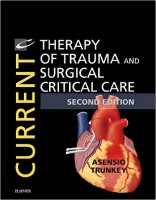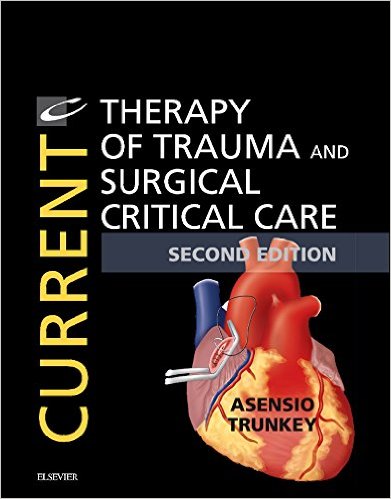 Editors: Juan A. Asensio, MD; and Donald D. Trunkey, MD
Editors: Juan A. Asensio, MD; and Donald D. Trunkey, MD
Publisher: Elsevier – 782 pages
Book Review by: Nano Khilnani
This book is one of the better-known ones on trauma care. Dr. Jeffrey T. Sugimoto, the chief of cardiothoracic thoracic surgery at Creighton University School of Medicine in Omaha who wrote the Foreword in this book, writes that the editors of this volume Drs. Asensio and Trunkey are “two of the well-recognized names in trauma.”
Along with those two editors, a large number of specialists and experts in trauma and critical care wrote the contents of this book: 281 people, mainly from all over the United States, and a few from Colombia, Japan, Saudi Arabia, and South Africa. The book contains numerous chapters (numbers not specified) that are organized into 15 Parts, namely:
- Trauma Systems
- Pre-Hospital Trauma Care
- Initial Assessment and Resuscitation
- Head and Central Nervous System Injuries
- Maxillofacial and Ocular Injuries
- Neck Injuries
- Thoracic Injuries
- Abdominal Injuries
- Special Issues in Major Torso Trauma
- Peripheral Vascular Injury
- Musculoskeletal and Peripheral Central Nervous System Injuries
- Special Issues and Situations In Trauma Management
- Critical Care I: Management of Organ Failures and Techniques For Support
- Critical Care II: Special Issues and Treatments
- Rehabilitation and Quality of Life After Trauma and Other Issues
This second edition contains updated, revised, and expanded sections. It contains information on a lot of subjects and topics, including:
- Brain death
- Care in the Intensive Care Unit
- Complete continuum of care
- Developments in imaging technology
- End-of-life care
- Mass casualty events
- Newer ventilatory techniques
- Operative procedures on the most complex of injuries
- Prevention of injury
- Rehabilitation of patients
- Specific organ injury management
- Treatment of vascular injuries
The organization of material in the chapters makes for easy reading, comprehension and retention of material. Let’s take a look in Part III Initial Assessment and Resuscitation. In its first chapter entitled Airway Management: What Every Trauma Surgeon Should Know, From Intubation to Cricothyroidotomy by Andrew R. Doben and Ronald I. Gross, you will find the following topics of discussion:
- Airway Anatomy
- Assessing the Airway
- Controlling the Airway
- Documentation of Proper Endotracheal Tube Placement
- Combitube
- Endotracheal Intubation
- Surgical Airway
There are various subtopics within the above-named topics that provide detailed coverage.
Large, fine-line drawings in color with labels, of the side and front views of the pharynx and its various parts help illustrate points on the topic of Airway Anatomy as listed above. Photos of tubes and instruments are shown under the topics Assessing the Airway and Controlling the Airway.
You will also find photographs of instruments and other visual learning aids such as charts and tables under the other topics listed above. At the end of this chapter, as with other chapters, you will find a Summary.
Elsevier offers enhanced eBooks for medical professionals. Compatible with PC, Mac, most mobile devices and eReaders, ExpertConsult allows you to browse, search and interact with this title – online and offline.
To get access to the contents of this book and other information online, first redeem your PIN from the inside front cover of the book. Here’s what you do:
- Login or Sign Up at www.ExpertConsult.com
- Scratch off the gray stickler on the book’s inside front cover to get your PIN code
- Enter PIN into the Redeem a Book Code box at the above website
- Click Redeem
- Go to My Library
Once you have logged in, these are the innovative features available to you online:
- Seamless, real-time integration between devices
- Straightforward navigation and search
- Notes and highlights sharing with other users through social media
- Enhanced images with annotations, labels, and hot spots for zooming on specific details *
- Live streaming video and animations
- Self-assessment tools such as questions embedded within the text and multiple-format quizzes. *Some features vary by title
You can get even more valuable information online from another useful allied website – www.ClinicalKey.com
This search engine of Elsevier Saunders is specially designed for doctors by providing them:
- Comprehensive Content – the most current, evidence-based answers available for every medical and surgical specialty.
- Trusted Answers – content supplied by Elsevier, the world’s leading provider of health and science information.
- Unrivaled Speed to Answer – faster, more relevant clinical answers, so you can spend less time searching and more time caring for your patients.
In summary and briefly, here are the benefits of owning this book
- Stay informed on a variety of key topics
- Get up to date with current developments
- Make the most of new antibiotics to improve control of surgical infection
- Benefit from tremendous recent advances in the field
- Consult this title for a quick overview before you enter the OR or ICU
- Review the essential principles of diagnosis and treatment
- Included with purchase is the eBook version.
This is an outstanding volume on trauma and surgical care: a must-own book.
Editors:
Juan A. Asensio, MD, FACS, FCCM, FRCS, KM is Professor of Surgery, and Chief of the Division of Trauma and Surgical Critical Care; and Director of the Trauma Center and Trauma Program in the Department of Surgery at Creighton University School of Medicine at Creighton University Medical Center at Omaha, Nebraska.
Donald D. Trunkey, MD, FACS is Professor Emeritus in the Department of Surgery, Division of Trauma, at Oregon Health and Science University in Portland, Oregon.







